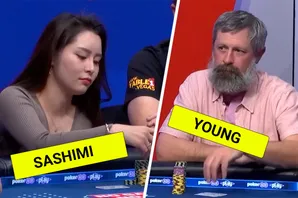You’ve almost certainly seen it in one of its many guises. The dogs playing poker painting is nothing short of iconic. It has spawned multiple recreations throughout the ages, paying homage to its intrigue and somewhat cult-like status among card players.
But what’s the story behind the dogs playing poker painting? Why has it endured for all these years? And what is its cultural significance in today’s world? Read on to find out how a simple depiction of dogs playing poker has achieved such global fame over the years.
The story behind the iconic dogs playing poker painting
Now, you’re probably aware that there isn't only one dogs playing poker painting. There are countless images depicting dogs sitting around a poker table with the best poker cards in front of them and a bottle of liquor in the foreground.
However, the original dogs playing poker piece – entitled simply Poker Game, and featured at the top of the page - was an 1894 oil painting by Cassius Marcellus Coolidge. Known colloquially as “Kash Koolidge,” he had little formal training as an artist and grew up in a humble Quaker family in New York.
Sometime in the 1870s, Coolidge started painting dogs in human situations, and he landed a partnership with the advertising firm Brown & Bigelow to create a series of oil paintings for them in the early 1900s. It was this commission that spawned the famous dogs playing poker piece, although Coolidge had created it several years prior.
In addition to the dogs around the poker table, he brought several other anthropomorphic dogs to life in the series, with One to Tie, Two to Win, Pinched with Four Aces, His Station and Four Aces and Ten Miles to a Garage, all featuring prominently at the time and in the decades that followed.

In 2015, more than a century after Coolidge created Poker Game, the piece sold at Sotheby’s New York for $658,000. But why has the image captured the imagination over the past 100 years? Where did the idea come from?
Marketing collateral: the creation of Coolidge’s series
It’s unclear what motivated Coolidge to humanise dogs as little is known about the artist’s life, and he never gave up any clues about his creativity. However, art critics have compared Poker Game with the works of Michelangelo and Cezanne, both of whom depict similar card scenes, albeit with humans – not dogs – as the subjects.
Coolidge’s work has also drawn parallels to some of the work of English artist Sir Edwin Landseer, who famously depicted dogs in a pensive, human-like state in Laying Down the Law (1840). But these comparisons are speculative and don’t shine a light on why Coolidge was motivated to bring his iconic painting to life.
We know that Coolidge was commissioned by the New York advertising firm Brown & Bigelow to produce 16 oil paintings, and he was likely given a brief as to what the firm was expecting. His paintings – of which Poker Game was one – appeared primarily on calendars and posters that became a national hit in the United States. Coolidge’s work found its way into the homes of millions of Americans.
So, while we will probably never know what motivated Coolidge to create the dogs playing poker painting, there’s no doubt that it was his partnership with Brown & Bigelow that brought the painting to the attention of the masses.

Dogs playing poker in popular culture in the United States
When Coolidge’s work first appeared in the public eye in the early twentieth century, nobody could have predicted how mainstream his creations would become. The painting exceeded expectations and became much more than marketing collateral in the mid-late twentieth century.
The eagle-eyed among us will know that Coolidge’s painting appears in many different forms in popular culture and has received cult-like status. Some of the shows in which the dogs playing poker painting have appeared include Family Guy, The Simpsons, Cheers, and Roseanne, among countless others.
As well as featuring in several shows on the small screen and films on the big screen, the painting caught Snoop Dog’s attention, and he decided to include it in his 1993 music video “What’s My Name?”
It’s fair to say, then, that the dogs playing poker painting has captured Americans’ imagination, and its legacy far exceeds what Coolidge and the team at Brown & Bigelow could have expected!

The legacy of dogs playing poker
Invariably, Poker Game is a painting that most Americans are familiar with, even if they’re unsure about its origins or rise to popularity. It’s a striking image, combining our love for animals with our passion for cards, hence its broad appeal to the masses.
Today, you can find variations of the dogs playing poker painting in practically every walk of life and emblazoned on various clothing products, memorabilia, and of course, in replica prints. You can hang a replica of Poker Game on the wall of your bachelor pad as you welcome your friends over for a night of poker, and it certainly won’t look out of place.

There are so many variations of Coolidge’s original painting that many people don’t know which is the original. Given that Coolidge produced several oil paintings of dogs playing cards during his career, it’s surprising that people aren’t necessarily sure of the original.
Still, the legacy of this much-loved painting endures today, and it is undoubtedly one of the most popular and much-loved poker-related pieces of artwork.
While it wasn’t intended to be a standalone masterpiece and was initially introduced as marketing collateral, we must thank Coolidge for his ingenuity and for bringing the iconic dogs playing poker painting into the world.
If you’re looking for an iconic addition to your home poker setup, alongside a top-notch poker table, there’s no doubt that a replica of Poker Game will impress your guests as you host your next poker night in the near future.
All images are in the Public Domain.



























